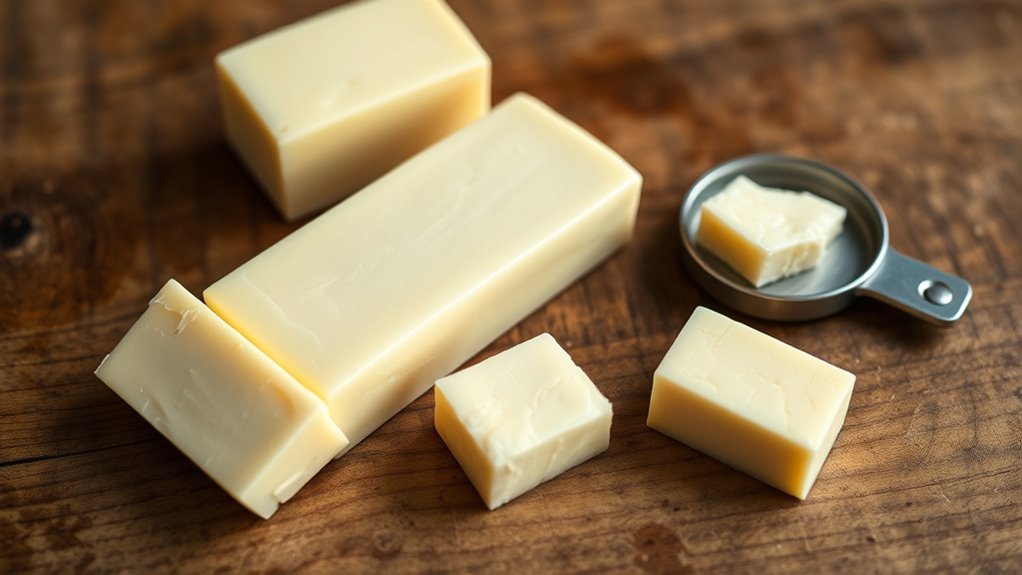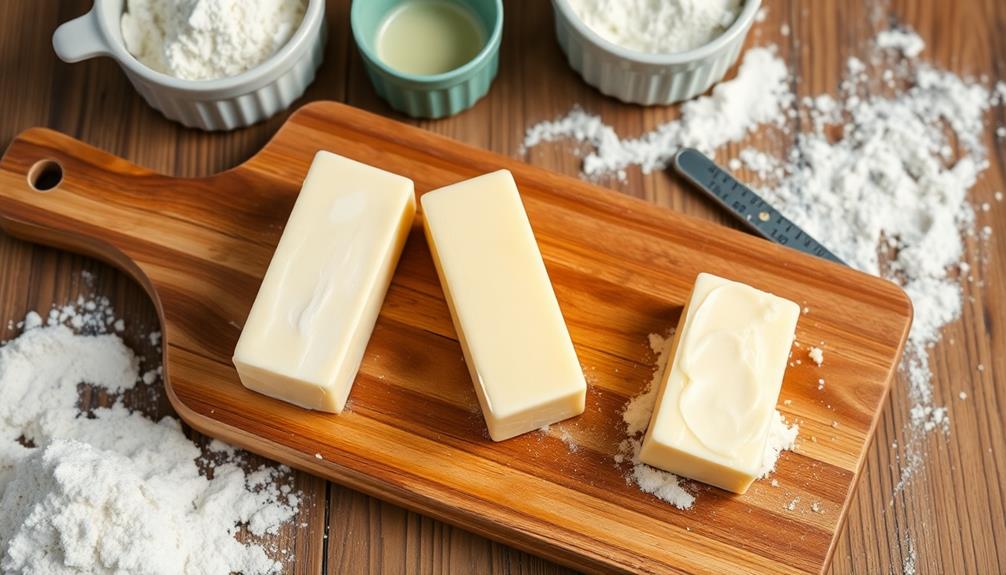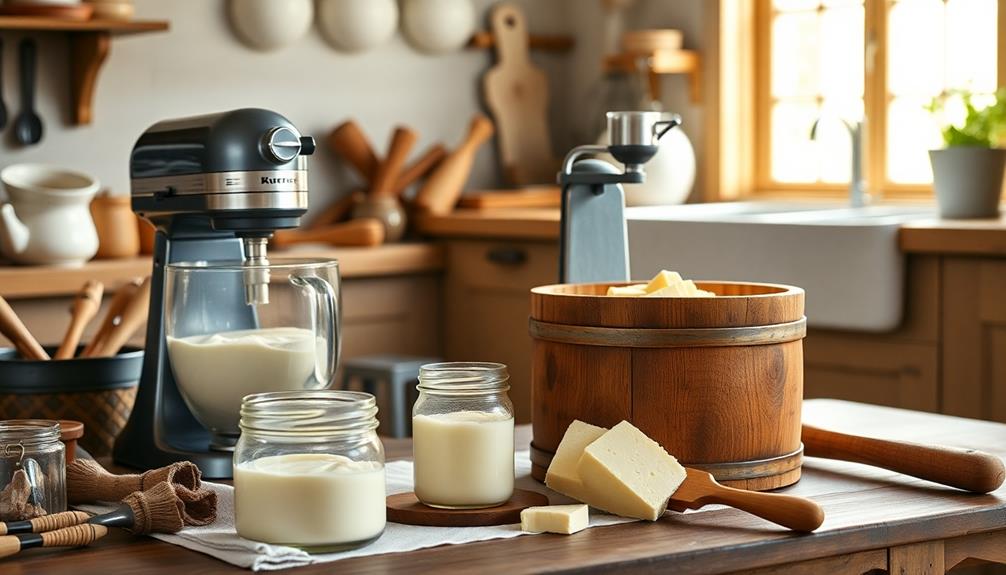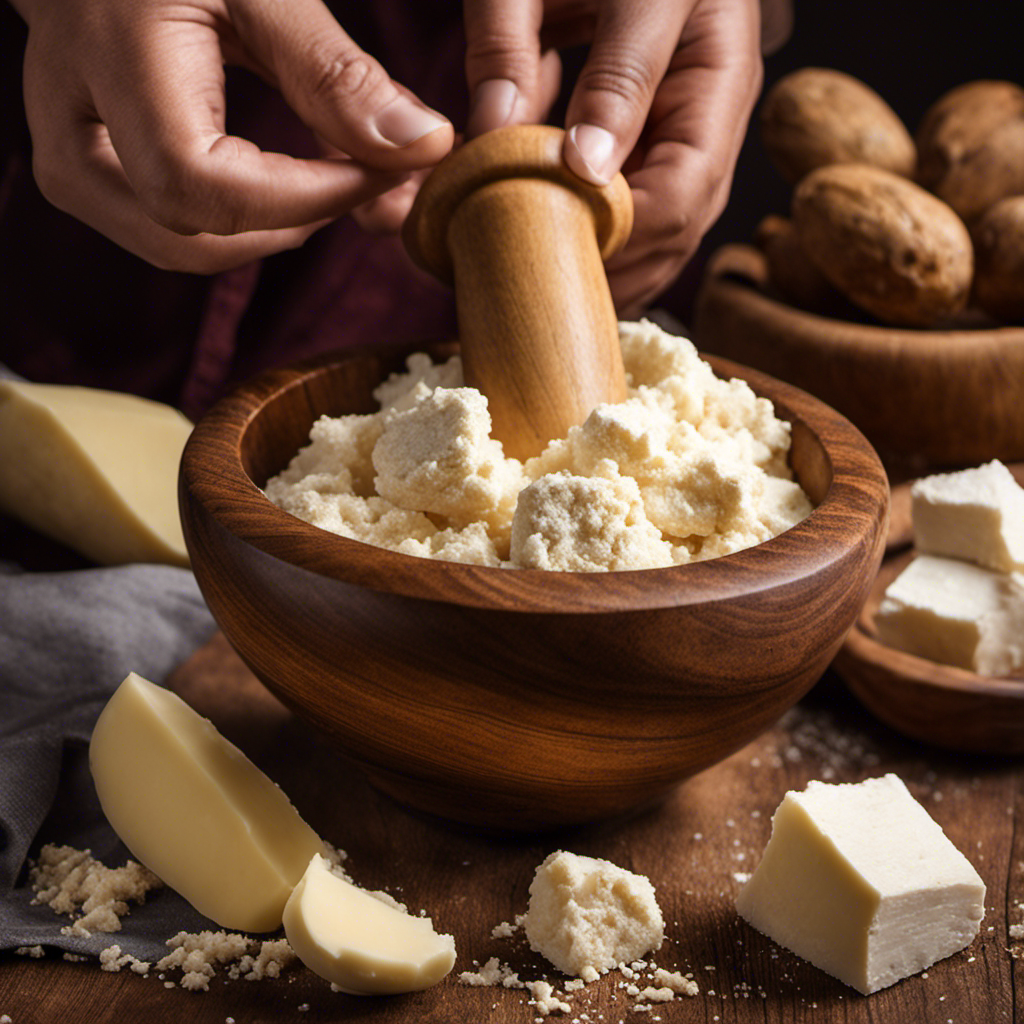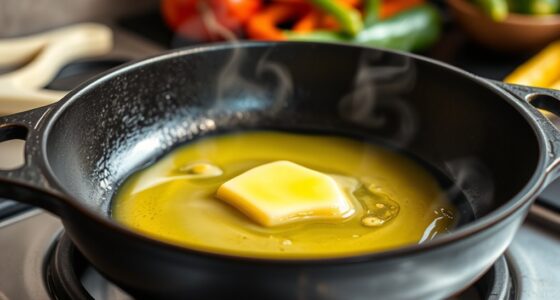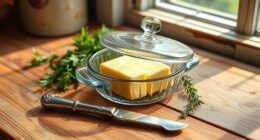If you want the most accurate way to portion butter, weighing it with a digital scale is your best bet because it provides precise measurements every time. Using butter sticks or blocks is convenient and quick, but they can be less exact unless you measure carefully. Techniques and tools like scales or mold allow for consistent results, especially in baking. Keep going to discover how each method can work best for your cooking needs.
Key Takeaways
- Weighing butter provides the highest accuracy, especially for precise baking and recipe adjustments.
- Butter sticks are pre-measured, offering quick and consistent portions for casual cooking needs.
- Butter blocks allow for precise cutting, ensuring uniform and customizable portions.
- Volume measurements (cups) are the least accurate, suitable for less critical cooking tasks.
- Using a digital scale with butter ensures optimal precision over sticks or volume estimates.
Understanding Traditional Butter Sticks and Their Measurements
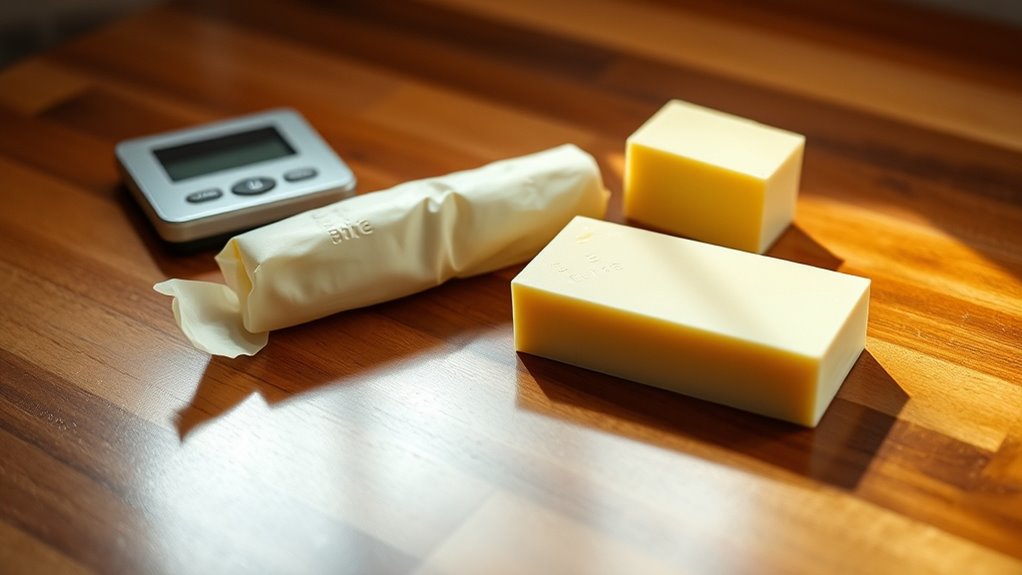
Traditional butter sticks are a common measurement in many recipes, and understanding their size helps you portion accurately. Typically, a standard stick weighs 4 ounces (113 grams) and provides about 1/2 cup of butter. Knowing this measurement guarantees you maintain the butter flavor balance in your dishes without overusing or wasting product. Proper storage techniques are essential to preserve freshness and prevent spoilage; keep butter refrigerated in its original wrapper or an airtight container. When using sticks, it’s easy to measure small amounts by simply slicing off what you need, which supports precise baking and cooking. Recognizing these standard measurements helps you achieve consistent results and keeps your ingredients fresh, ensuring your recipes turn out just as intended. Additionally, understanding newborn sleep patterns can help you plan your cooking schedule around your baby’s needs.
The Advantages of Using a Butter Block for Precision

Using a butter block offers greater accuracy compared to traditional sticks because it allows you to cut exact amounts without guesswork. This control enhances your ability to maintain consistent butter flavor in recipes and guarantees precise measurements for baking or cooking. Plus, butter blocks are easier to store properly, preserving freshness with better storage techniques. The uniform shape helps prevent spoilage and minimizes waste. Additionally, the design of butter blocks makes arcade game maintenance simpler, ensuring your butter stays fresh longer and reducing the need for frequent replacements.
How Weighing Butter Offers the Highest Accuracy
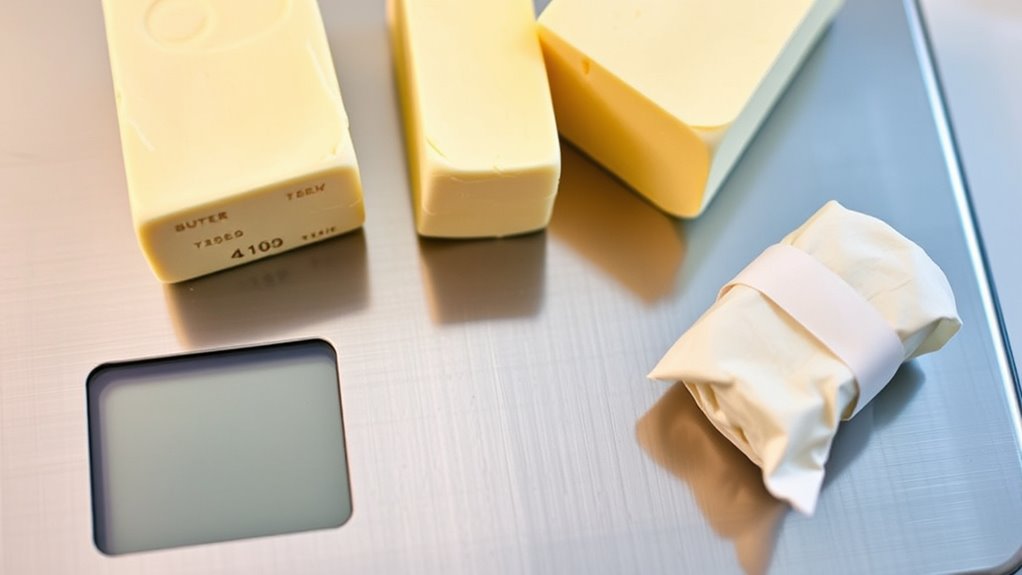
Using a scale guarantees you get the most accurate butter portions every time. Precise measurement techniques help you control portion size consistently, reducing waste and maintaining quality. When you weigh your butter, you can trust that each piece meets your exact specifications. Additionally, high precision tools ensure your measurements remain consistent across multiple uses.
Precise Measurement Techniques
Weighing butter provides the most accurate measurement because digital scales can detect even small differences in weight. This precision guarantees you get the exact amount needed for your recipes, preserving the butter’s intended flavor and texture. Accurate measurement also helps maintain proper storage methods, preventing waste or spoilage caused by over- or under-measuring. When you weigh butter, you avoid the inconsistencies that come with estimating or using visual cues, which can affect the final dish’s quality. Plus, precise portioning supports better control over butter’s flavor intensity, especially in baking where small variations matter. Using a digital scale simplifies the process, making it easy to achieve consistent results every time, regardless of whether you prefer sticks or blocks. Additionally, understanding measurement techniques can further enhance your baking precision and consistency.
Consistent Portion Control
Because precise portion control is essential for consistent results, weighing butter guarantees you get the same amount every time. This consistency helps you maintain nutritional differences, ensuring your recipes and diet stay accurate. Relying on weight eliminates guesswork and discrepancies caused by measuring sticks or blocks, which can vary slightly. Additionally, weighing respects cultural traditions that emphasize exact measurements, preserving authenticity in recipes. When you measure butter by weight, you avoid potential errors from melting or softening, which can change volume but not weight. This method provides uniform portions, making meal prep more reliable and reducing waste. It also aligns with the practice of adventure in exploration, where embracing precise methods can lead to more successful outcomes. Ultimately, weighing butter helps you achieve predictable, high-quality results while honoring diverse culinary practices.
Comparing Ease of Use: Sticks, Blocks, and Scales

When it comes to portioning butter, choosing the easiest method can make your prep more efficient. Butter sticks are quick and convenient, with pre-measured servings that save time and reduce mess. They’re ideal if you value consistency, and their packaging helps with proper storage tips to keep butter fresh. Blocks require a bit more effort—you’ll need a knife or grater—but offer flexibility for custom portions. Scales provide the most precision, especially when measuring for specific recipes, but may slow you down during busy times. In terms of ease of use, sticks are the simplest, especially for quick cooking. Blocks and scales demand more effort, but they can enhance your control over butter flavor and quality, especially if you want exact measurements for baking or dietary needs. Understanding design thinking principles can also help in choosing the best method tailored to your cooking style and needs.
Common Mistakes When Portioning Butter and How to Avoid Them
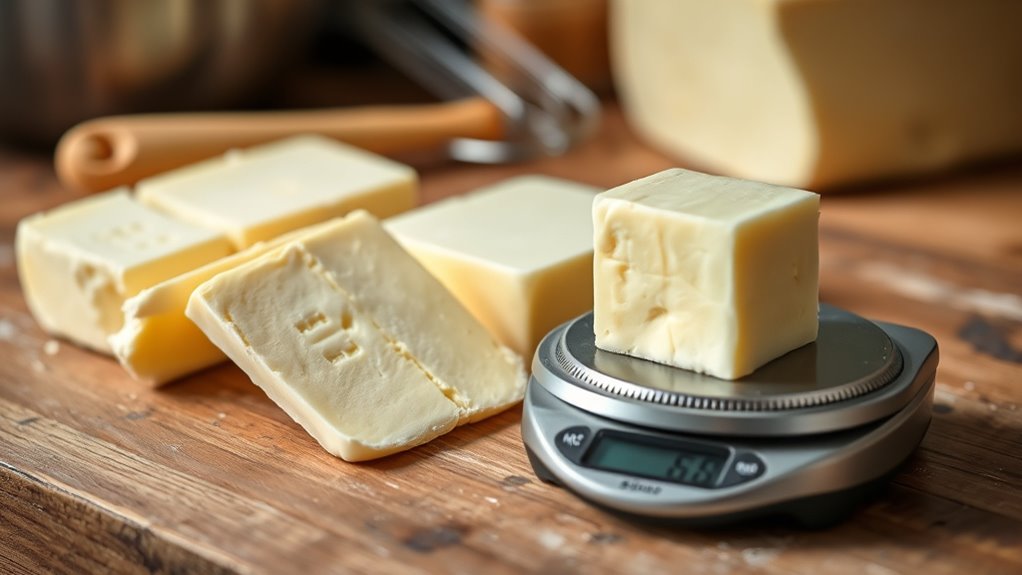
One common mistake is using inconsistent measurement techniques, which can lead to uneven portions. You might also overlook the importance of proper tools, making your measurements less accurate. To avoid these errors, make certain you use the right tools and stick to a reliable measuring method every time. Additionally, understanding the accuracy of measurement methods can help ensure the most precise portioning results.
Inconsistent Measurement Techniques
Inconsistent measurement techniques can lead to uneven butter portions that disrupt recipes and waste product. When you rely on vague methods like estimating by eye or using inconsistent tools, you risk affecting the butter flavor and overall dish quality. Improper portioning can also impact storage techniques, causing butter to spoil faster or become freezer-burned if not measured accurately. To avoid these mistakes, always use precise tools like a scale or standardized measuring methods. Be consistent with your technique, whether you’re slicing, weighing, or measuring a stick or block. Clear, accurate portions help maintain butter’s flavor integrity and ensure your recipes turn out as intended. Consistency in measurement is key to minimizing waste and achieving professional results.
Overlooking Proper Tools
Failing to use the right tools when portioning butter often leads to inaccurate measurements and uneven servings. Many people skip proper measuring utensils or rely solely on eyeballing, which can cause inconsistencies. Using a kitchen scale ensures precise weight measurements, especially when portioning by weight. If you prefer measuring by volume, invest in good measuring spoons or cups designed for solids. Avoid using unreliable tools like makeshift spreads or unmarked containers, as they increase the risk of errors. Proper tools help you achieve consistent portions, whether you’re dividing butter for baking or serving. Always double-check measurements with a kitchen scale if accuracy is critical. By choosing the right measuring utensils and scales, you ensure each portion is perfect and reliable.
Tips for Achieving Consistent Butter Measurements in Recipes

To guarantee your recipes turn out perfectly every time, it’s important to measure butter accurately and consistently. Using the right method preserves butter flavor and ensures proper results. Keep your butter stored properly—cool, wrapped, and away from air—to maintain freshness and easy portioning. When measuring, consider the butter’s form: stick, block, or weight. For precision, weigh butter with a kitchen scale, avoiding the inconsistencies of volume methods. If using a stick or block, cut clean, even pieces with a sharp knife. To help visualize, here’s a quick guide:
| Method | Best For | Tips |
|---|---|---|
| Weight | Precise baking | Use a digital scale |
| Stick | Quick, in recipes | Slice evenly |
| Volume | Less critical cooking | Use measuring cups |
| Storage | Long-term freshness | Keep wrapped and cool |
Additionally, understanding how different tuning methods can optimize your vehicle’s performance can be beneficial for enthusiasts.
When to Prefer Each Method Based on Different Cooking Contexts
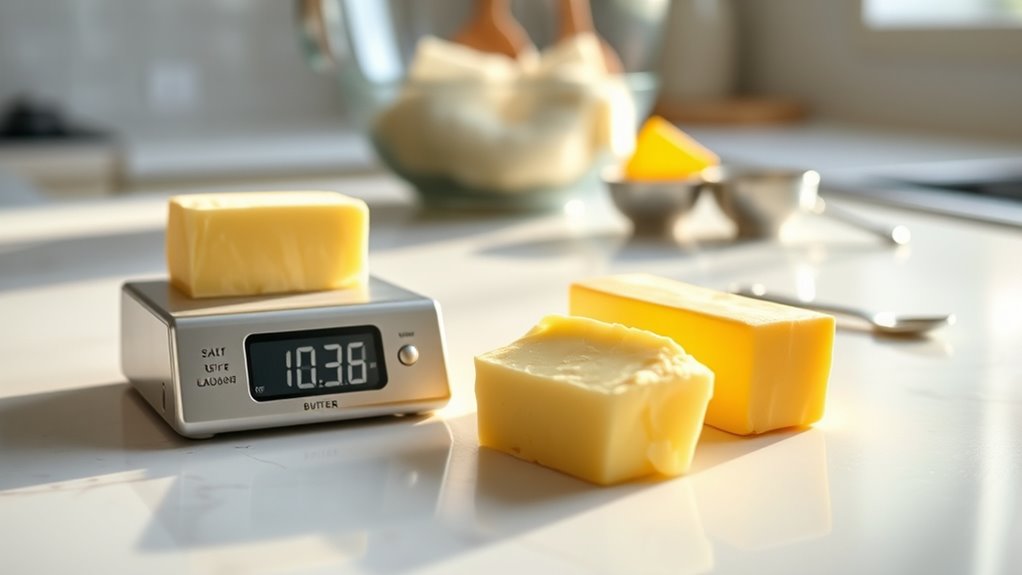
Choosing the right butter measurement method depends on the cooking or baking task at hand. Consider these situations:
- For delicate baked goods, use weighing to ensure consistent butter flavor and precise measurements.
- When melting butter for sauces, a stick or block makes quick, even melting easier, especially with different storage methods.
- If you’re preparing a large batch, weighing offers accuracy regardless of butter’s form, helping maintain flavor balance.
- For casual cooking or spreads, sticking to sticks or blocks simplifies measurement without sacrificing quality.
Each method’s suitability depends on storage methods—softened butter for spreading, frozen for storage, or measured in weight for accuracy. Choosing wisely guarantees your recipe’s flavor and texture stay on point.
Tools and Accessories to Improve Butter Portioning Accuracy
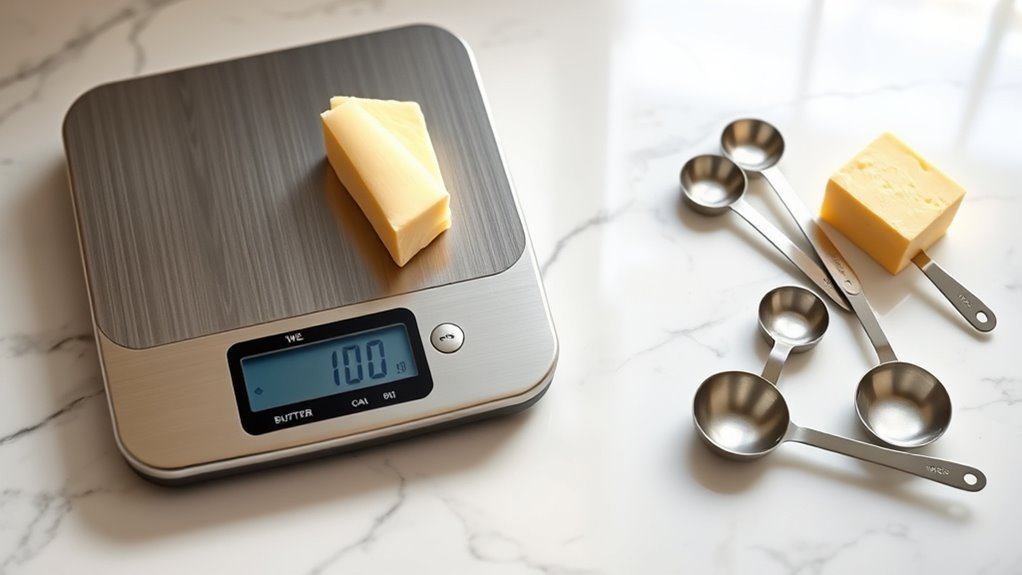
Using the right tools can substantially enhance your butter portioning accuracy and streamline your kitchen workflow. A digital kitchen scale is essential for precise weight measurements, ensuring consistent portions that preserve butter flavor and melting point. Butter portioning tools like butter molds or portioning knives help you shape butter evenly, reducing waste and maintaining quality. For softer butters, a butter cutter or hot knife can improve precision, especially when handling different textures. Measuring cups with clear markings assist in quick, approximate portions when exact weight isn’t critical. Using these accessories minimizes errors caused by melted or softening butter, preserving its ideal melting point and flavor. Investing in accurate tools makes butter measurement straightforward, ensuring better results in your recipes while saving time and reducing mess. Additionally, retail hours for these tools can vary, so checking availability at local stores or online can help you plan your shopping effectively.
Frequently Asked Questions
How Do Different Countries’ Butter Measurements Vary?
You’ll notice that butter measurement standards vary globally, reflecting international measurement differences. In the US, butter is often measured in sticks, typically weighing 113 grams each, while many other countries use grams or kilograms for precision. European countries, for example, use grams, and the UK often references weight in grams or ounces. Understanding these differences helps you adapt recipes and guarantees accuracy across borders.
Can Digital Scales Measure Small Butter Portions Accurately?
Think of digital scales as your butter’s best friend—trustworthy and precise. They can measure small butter portions with a high degree of measurement accuracy, making sure each dollop is just right. With a gentle tap, your digital scale transforms a simple task into an art of accuracy, ensuring consistent results. So yes, when you need precision, digital scales are your go-to tools for measuring small butter portions reliably.
Are There Health Benefits to Precise Butter Portioning?
When it comes to health benefits, precise butter portioning helps you with calorie counting and portion control. By measuring accurately, you avoid over-consuming fats and calories, which supports weight management and heart health. Using tools like digital scales or pre-measured servings makes it easier to stick to your dietary goals. Small, consistent portions give you better control and help you maintain a balanced diet, ultimately improving your overall health.
How Does Butter Temperature Affect Portioning Accuracy?
You might find that butter melting affects portioning accuracy because warmer butter becomes softer and harder to cut precisely. Maintaining good temperature control keeps butter firm, making it easier to measure accurately. When butter melts or gets too soft, it can lead to uneven portions, affecting recipes and calorie counts. To get consistent portions, keep your butter cold and work quickly, ensuring accurate measurements regardless of temperature fluctuations.
What Are Eco-Friendly Options for Butter Packaging and Measurement?
You can choose eco-friendly measurements like reusable silicone molds or digital scales with sustainable batteries to reduce waste. For packaging, look for sustainable packaging options such as biodegradable wraps, recyclable cartons, or compostable containers that minimize environmental impact. These eco-friendly measurements and sustainable packaging options help you cut down on plastic use, promote environmental responsibility, and support greener practices in butter portioning, making your process more sustainable overall.
Conclusion
Choosing the right butter portioning method is like selecting the perfect brush for your masterpiece—each has its own rhythm and purpose. Whether you prefer the familiar stick, the versatile block, or the precision of weighing, mastering these techniques guarantees your recipes turn out just right. Think of your tools as your culinary palette—use them wisely, and every dish will be a work of art, smooth and flawless as butter itself.
